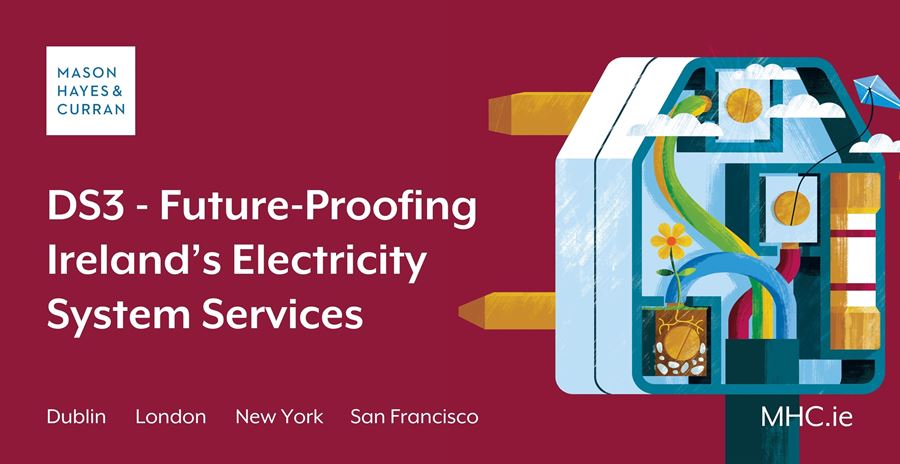
The DS3 system services procurement regime is a crucial pillar of Ireland’s decarbonisation effort, as it helps facilitate the deployment of renewable electricity generation across the grid. DS3 is operated in Ireland by EirGrid plc, the operator of the electricity transmission system, or TSO, and in recent years has driven significant innovation and investment, involving new categories of electricity generation and storage assets. We now explore the latest developments in the DS3 programme, as Ireland’s energy regulator looks to future-proof the regime out to 2030.
To increase the percentage of Ireland’s electricity demand that can be securely served by renewable generators, EirGrid plc pays for highly technical system services from electricity market participants that are capable of providing them. These services include operating reserve, frequency response and ramping capabilities. The procurement regime is known as “DS3”.
The DS3 programme has developed in a number of increments since it was established in 2011. It is now poised to enter a new phase with the implementation of the System Services Future Arrangements (SSFA) project. The SEM Committee, the regulators in charge of the wholesale electricity market on the island of Ireland, are currently consulting the public on the final high-level design aspects of the SSFA.
It is intended that the SSFA will establish a stable DS3 regulatory framework through to at least 2030, in the interests of providing “clarity for investors and transparency for stakeholders.”
The key DS3 design issues are:
-
For how long, in each year, should a procurement “window” be open for new projects seeking to commence providing DS3 services?
The preference of the SEM Committee is that this window will now widen into a continuous process. This should enhance and accelerate the procurement of services from new projects.
-
How will the DS3 regime, including its rules, be governed?
Currently, the programme is administered exclusively by the transmission system operators (TSOs), under the supervision of the SEM Committee. The favoured SSFA proposal is that the DS3 rules are formalised into a Code that is governed by a modifications panel. This panel would consist of the TSOs and industry representatives, with the SEM Committee retaining a final approval role. DS3 governance would thereby be brought into line with the arrangements that govern the Single Electricity Market for wholesale electricity.
-
Who should pay for the DS3 regime?
At present, the forecast DS3 costs are “smeared” across all users of the electricity system. By contrast, the SSFA proposal will see these costs targeted towards periods in which the need for the DS3 services is highest. Typically, these are periods during which renewable generation is most active.
-
When should DS3 auctions be held?
It had previously been decided that the competitive procurement of DS3 services would take place daily. This is a significant change from the occasional procurement cycle that currently applies. The timing of the DS3 auction now needs to be anchored precisely within the daily “life cycle” of electricity pricing in the wholesale market. The SEM Committee’s preference is that the auction will be held after the day ahead market has closed, but before scheduling.
Conclusion
The latest SSFA consultation, and the preferred positions of the SEM Committee on the various consultation questions, demonstrate clearly that the market design for DS3 services is approaching a stable, mature equilibrium. Existing participants in the Irish electricity sector are used to codes, modifications panels and daily auctions, and will therefore recognise the shape of the governance and auction arrangements that are proposed.
This level of familiarity should serve to attract further investment and participation in the DS3 programme, and thereby allow the Irish electricity system to accommodate the further development of renewable sources of electricity.
For any electricity market questions, contact a member of our Energy, Utilities & Projects team.
The content of this article is provided for information purposes only and does not constitute legal or other advice.


